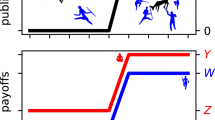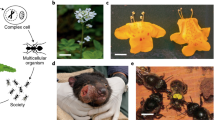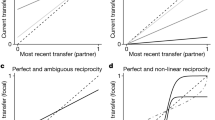Abstract
Explaining the rise and maintenance of cooperation is central to our understanding of biological systems1,2 and human societies3,4. When an individual’s cooperativeness is used by other individuals as a choice criterion, there can be competition to be more generous than others, a situation called competitive altruism5. The evolution of cooperation between non-relatives can then be driven by a positive feedback between increasing levels of cooperativeness and choosiness6. Here we use evolutionary simulations to show that, in a situation where individuals have the opportunity to engage in repeated pairwise interactions, the equilibrium degree of cooperativeness depends critically on the amount of behavioural variation that is being maintained in the population by processes such as mutation. Because our model does not invoke complex mechanisms such as negotiation behaviour, it can be applied to a wide range of species. The results suggest an important role of lifespan in the evolution of cooperation.
This is a preview of subscription content, access via your institution
Access options
Subscribe to this journal
Receive 51 print issues and online access
$199.00 per year
only $3.90 per issue
Buy this article
- Purchase on Springer Link
- Instant access to full article PDF
Prices may be subject to local taxes which are calculated during checkout



Similar content being viewed by others
References
Axelrod, R. & Hamilton, W. D. The evolution of cooperation. Science 211, 1390–1396 (1981)
Trivers, R. Social Evolution (Benjamin/Cummings, Menlo Park, California, 1985)
Fehr, E. & Fischbacher, U. The nature of human altruism. Nature 425, 785–791 (2003)
Wedekind, C. & Milinski, M. Cooperation through image scoring in humans. Science 288, 850–852 (2000)
Roberts, G. Competitive altruism: from reciprocity to the handicap principle. Proc. R. Soc. Lond. B 265, 427–431 (1998)
Sherratt, T. N. & Roberts, G. The evolution of generosity and choosiness in cooperative exchanges. J. Theor. Biol. 193, 167–177 (1998)
Dawes, R. M. Social Dilemmas. Annu. Rev. Psychol. 31, 169–193 (1980)
Killingback, T. & Doebeli, M. The continuous prisoner’s dilemma and the evolution of cooperation through reciprocal altruism with variable investment. Am. Nat. 160, 421–438 (2002)
Enquist, M. & Leimar, O. The evolution of cooperation in mobile organisms. Anim. Behav. 45, 747–757 (1993)
Hamilton, I. M. & Taborsky, M. Contingent movement and cooperation evolve under generalized reciprocity. Proc. R. Soc. B 272, 2259–2267 (2005)
Houston, A. I. & Davies, N. B. in Behavioural Ecology (eds Sibly, R. M. & Smith, R. H.) 471–487 (Blackwell Scientific Publications, Oxford, 1985)
McNamara, J. M., Houston, A. I., Barta, Z. & Osorno, J. L. Should young ever be better off with one parent than with two? Behav. Ecol. 14, 301–310 (2003)
Parker, G. A. Models of parent–offspring conflict. V. Effects of the behavior of the two parents. Anim. Behav. 33, 519–533 (1985)
Doebeli, M., Hauert, C. & Killingback, T. The evolutionary origin of cooperators and defectors. Science 306, 859–862 (2004)
Houston, A. I., Szekely, T. & McNamara, J. M. Conflict between parents over care. Trends Ecol. Evol. 20, 33–38 (2005)
McNamara, J. M. & Houston, A. I. Evolutionarily stable levels of vigilance as a function of group-size. Anim. Behav. 43, 641–658 (1992)
Maynard Smith, J. Evolution and the Theory of Games (Cambridge Univ. Press, Cambridge, 1982)
Doebeli, M. & Hauert, C. Models of cooperation based on the Prisoner’s Dilemma and the Snowdrift game. Ecol. Lett. 8, 748–766 (2005)
Queller, D. C. Kinship, reciprocity and synergism in the evolution of social behavior. Nature 318, 366–367 (1985)
McNamara, J. M., Barta, Z. & Houston, A. I. Variation in behaviour promotes cooperation in the Prisoner’s Dilemma game. Nature 428, 745–748 (2004)
McNamara, J. M. & Forslund, P. Divorce rates in birds: predictions from an optimization model. Am. Nat. 147, 609–640 (1996)
McNamara, J. M., Forslund, P. & Lang, A. An ESS model for divorce strategies in birds. Phil. Trans. R. Soc. Lond. B 354, 223–236 (1999)
Hauert, C., De Monte, S., Hofbauer, J. & Sigmund, K. Volunteering as Red Queen mechanism for cooperation in public goods games. Science 296, 1129–1132 (2002)
Hruschka, D. J. & Henrich, J. Friendship, cliquishness, and the emergence of cooperation. J. Theor. Biol. 239, 1–15 (2006)
Ens, B. J., Safriel, U. N. & Harris, M. P. Divorce in the long-lived and monogamous oystercatcher, Haematopus ostralegus – incompatibility or choosing the better option. Anim. Behav. 45, 1199–1217 (1993)
Moody, A. T., Wilhelm, S. I., Cameron-MacMillan, M. L., Walsh, C. J. & Storey, A. E. Divorce in common murres (Uria aalge): relationship to parental quality. Behav. Ecol. Sociobiol. 57, 224–230 (2005)
Triefenbach, F. & Itzkowitz, M. Mate switching as a function of mate quality in convict cichlids, Cichlasoma nigrofasciatum . Anim. Behav. 55, 1263–1270 (1998)
Brown, M., Falk, A. & Fehr, E. Relational contracts and the nature of market interactions. Econometrica 72, 747–780 (2004)
Andersson, M. & Simmons, L. W. Sexual selection and mate choice. Trends Ecol. Evol. 21, 296–302 (2006)
Sih, A., Bell, A. & Johnson, J. C. Behavioral syndromes: an ecological and evolutionary overview. Trends Ecol. Evol. 19, 372–378 (2004)
Acknowledgements
We thank O. Leimar and four anonymous referees for comments on a previous version of this paper. Z.B. was supported by a grant from the Biotechnology and Biological Sciences Research Council to A.I.H. and J.M.M. L.F. was supported by the Deutsche Forschungsgemeinschaft.
Author Contributions Based on an idea by J.M.M., the concept for this paper was developed in discussions among all authors. J.M.M. also formulated the material in Box 1 and most of the Supplementary Information; Z.B. performed the computations and prepared the figures; A.I.H. surveyed the literature; L.F. had the main responsibility for writing the paper.
Author information
Authors and Affiliations
Corresponding author
Supplementary information
Supplementary Information
The file contains Supplementary Notes with model description and Supplementary Figures1-2 with Legends. These components can be further described as follows:1) A plot of the cost and benefit functions used in the model; 2) A plot showing the effect of mortality on the location of equilibria, and on the time needed to reach these equilibria, in our simulations; 3) A technical description of how the computer simulation was implemented and 4) The analytical derivation of some key results of our model, using the Continuous Prisoner's Dilemma with linear cost and benefit functions as an example. (PDF 162 kb)
Rights and permissions
About this article
Cite this article
McNamara, J., Barta, Z., Fromhage, L. et al. The coevolution of choosiness and cooperation. Nature 451, 189–192 (2008). https://doi.org/10.1038/nature06455
Received:
Accepted:
Issue Date:
DOI: https://doi.org/10.1038/nature06455
This article is cited by
-
Social anxiety in modern societies from an evolutionary perspective
Discover Psychology (2023)
-
Political Alliance Formation and Cooperation Networks in the Utah State Legislature
Human Nature (2022)
-
High pair fidelity despite sex differences in the duration of parental care in a long-lived migratory bird
Behavioral Ecology and Sociobiology (2022)
-
Anthropological Prosociality via Sub-Group Level Selection
Integrative Psychological and Behavioral Science (2022)
-
These confabulations are guaranteed to improve your marriage! Toward a teleological theory of confabulation
Synthese (2021)
Comments
By submitting a comment you agree to abide by our Terms and Community Guidelines. If you find something abusive or that does not comply with our terms or guidelines please flag it as inappropriate.



